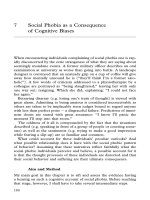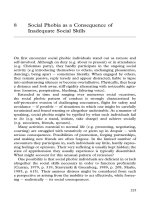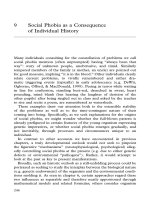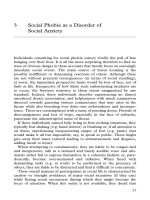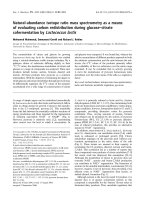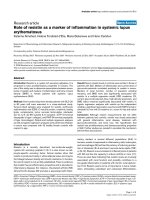“Good” Legislation as a Means of Ensuring Voice, Accountability, and the Delivery of Results in Urban Development
Bạn đang xem bản rút gọn của tài liệu. Xem và tải ngay bản đầy đủ của tài liệu tại đây (275.82 KB, 14 trang )
11
“Good” Legislation as a Means
of Ensuring Voice, Accountability,
and the Delivery of Results
in Urban Development
MARIA MOUSMOUTI
AND
GIANLUCA CRISPI
Urban legislation is a pillar of sustainable urban development. It is an important development tool that lays down, in binding rules, acceptable behaviors
in society and the rights and obligations of parties and governance frameworks in different areas of life. The global urban population is expected to
grow by 3 billion in the next 50 years, with 98 percent of this growth occurring
in developing countries.1 Such unprecedented growth could result in anarchy
and increased inequalities if not underpinned by strong and coherent policy and legal, institutional, and governance frameworks that ensure a solid
context for planning, dialogue among actors, and rights-based approaches to
development.
Urban areas dominate economies, drive technological development, and
provide shelter and livelihoods. The quality of human se lements and urban
governance affects the quality of life for millions of individuals. In this context, urban legislation defines conditions for access to land, infrastructure,
housing, and basic services; it lays out rules for planning, decision making,
and participation; it guides the improvement of livelihoods and living conditions by se ing requirements for urban development initiatives; and it sets the
context within which urban authorities, local governments, and communities
are expected to fulfill their mandates, react to emerging challenges, and be
accountable. Urban law provides a framework in which to mediate and balance competing public and private interests, especially in relation to land use
and development; to create a stable and predictable framework for public and
private sector action; to guarantee the inclusion of the interests of vulnerable
groups; and to provide a catalyst for local and national discourse.2 In other
words, legislation determines the context, conditions, and terms of the social
contract for urban development. Legislation can set meaningful sustainable
frameworks for development, give voice to affected people and communities, and set appropriate frameworks for accountability, or it can accentuate
inequalities and exclusion.
1
U.N. Dept. Econ. & Soc. Affairs, World Urbanization Prospects: 2011 Revision (U.N. 2012).
2
UN-Habitat, Global Report on Human Se lements 215 (U.N. 2009).
257
258
The World Bank Legal Review
The Challenge: The Definition of Good Urban Legislation
The mere existence of legislation does not ensure effective urban management
and development. Legislation can generate more problems than it actually
solves. Unclear or ambiguous provisions that are complex, overlapping, or
leave gaps in protection, that are difficult to access or understand and poorly
enforced and implemented, with high compliance costs and unwanted effects,
will have a negative impact on competitiveness and economic growth. Outdated, complex, and rigid legislation has hindered development and compelled citizens and administrators to seek informal arrangements and corrupt
means to access basic services. Businesses, citizens, professional groups, consumers, and other stakeholders often complain about the negative effects of
bad or unnecessary legislation. If legislation lays down the terms of a social
contract and determines the framework for social development, its quality is
of primary importance. In other words, what is needed for sustainable development is not just legislation but good legislation.
Legislation often suffers from misguided assumptions or overambitious
expectations, inadequate appraisal of costs and consequences, unrealistic
expectations, and severe gaps between intention and reality, as has been the
experience in many African countries.3 Planning laws are often outdated,
irrelevant, and inappropriate for the contexts within which they operate.
Laws that fail to make land available in pace with rapid urbanization result in
insufficient land supply, increases in land prices, and the formation of slums.
Laws that are not in line with the needs of the people and local socioeconomic
realities such as urban poverty result in noncompliance and a loss of credibility for the planning system, not to mention their selective application in
favor of specific groups or elites. Other common problems include regulatory
barriers that limit opportunities in formal land markets, exacerbate inequality,
and discourage investments; laws with high compliance costs; and laws that
are not enforced or implemented.4 A result of failed planning laws is the predominance of informal structures and the prevalence of the interests of elites
over large groups of the population:5 legislation designed to protect the public
from the negative aspects of urban land development may be used to enhance
the value of land owned by the wealthy.
Whereas cities can be drivers of economic growth, dysfunctional cities
cannot harness the economies derived from the agglomeration of population,
common infrastructures, and the availability and diversity of labor and market size. Instead, they generate congestion and high costs for infrastructure
and services and cannot support the creation of sufficient jobs and quality
of life for their residents, with broad-ranging consequences, including social
unrest and insecurity. If legislation is a prerequisite for urban governance,
3
Stephen Berrisford, How to Make Planning Law Work for Africa 3–4 (Africa Res. Inst. 2013).
4
Id., at 2.
5
Id.
“Good” Legislation as a Means of Ensuring Voice, Accountability, 259
and the Delivery of Results in Urban Development
good urban legislation is a precondition for sustainable urban development.
But what is a good law?
Although everyone may agree on the need for “good laws,” the features
of a good law are not obvious. When it comes to legislation, quality is a broad
and vague term, perceptions of which differ depending on the viewpoints of
different actors, legal traditions, and social and political contexts. Even when
it comes to specific areas such as urban legislation, different professions have
different opinions: planners, lawyers, and developers do not share the same
language, views, or ideas or necessarily see eye to eye.6
Although there is no single understanding of quality in legislation, common values characterize good legislation: efficacy, effectiveness, efficiency,
and simplicity.7 Views differ on the values that should prevail: whereas lawyers tend to stress principles like legal certainty, economists tend to favor
efficiency and political scientists tend to emphasize efficacy. One aspect of
good legislation on which everyone agrees is the need for laws to be effective.8 Effective legislation sets rules that address existing problems, takes into
account the voice of affected people and communities, ensures accountability,
and can deliver the results it promises. What makes a law effective?
The effectiveness of legislation is largely determined by its purpose, substantive content, legislative expression, overarching structure, and results.9
Effective legislation needs to have a clear purpose; introduce consistent and
well-thought-out rules and enforcement mechanisms that realistically address
the targeted problems; introduce clear, precise, and unambiguous rules and
obligations; and allow for systematic monitoring and evaluation of the results
of legislation in real life.10 If these elements are in place, the basic conditions
for effective legislation are fulfilled. In the opposite situation, if legislation is
unclear, poorly articulated, or suffers from internal tensions or imbalances, it
has few chances to succeed.
Ineffective urban and planning laws reflect different pathologies of ineffective legislation: blurred or inconsistent choices, unclear or ambitious objectives, rules whose impact has not been considered, lack of consideration of enforcement and implementation issues, inconsistent or contradictory drafting
choices, and limited, fragmented, or nonexistent information on the application
6
Patrick McAuslan, Land, Law, and Planning 12–30 (Weidenfeld & Nicolson 1975).
7
Helen Xanthaki, On the Transferability of Legislative Solutions: The Functionality Test, in Drafting
Legislation: A Modern Approach 1–18 (Constantin Stefanou & Helen Xanthaki eds., Ashgate
2008).
8
Helen Xanthaki, Quality of Legislation: An Achievable Universal Concept or An Utopia Pursuit?,
in Quality of Legislation: Principles and Instruments 75–85 (Luzius Mader & Mart Tavres de
Almeida eds., Nomos 2011).
9
Maria Mousmouti, Effectiveness as an Aid to Legislative Drafting, 2 Loophole 15–25 (2014),
h p://www.opc.gov.au/CALC/docs/Loophole/Loophole_May14.pdf.
10
Id., at 23.
260
The World Bank Legal Review
and the results of legislation. If good urban legislation is what is needed, then
it is necessary to address these pathologies.
Improving the Quality of Urban Legislation
Improving the quality of legislation is not an easy or straightforward ma er.
However, it is indispensable for ensuring delivery in a development context.
Efforts have led to the development of strategies and tool kits to improve regulatory governance, support decision making, improve legislative drafting, and
rationalize lawmaking. These efforts have focused on improving the content
of legislation and its responsiveness to local realities, taking into account the
voices of affected groups and communities, making legislation simple, clear,
and accessible, and ensuring that it can deliver results. This section examines
alternative ways to improve the quality of legislation.
Address the Incongruity between the Law and Urban Realities
Urban laws often fail because their content is detached from local realities. Laws
are often overambitious, set unrealistic objectives, and are irrelevant to local
needs and conditions. In other words, laws fail because they do not set a realistic and feasible context for development. For example, in the Nigerian state of
Kogi, regulation on the size of plots determines an acceptable size that ranges
from 900 to 1,350 square meters. These requirements are in discordance with
the needs of dense urban centers, smaller cities, and urban areas in the country,
and place plots out of reach of the majority of the low-income population.11
Building standards are often regulated without taking into account local
incomes, climates, traditional building techniques, and locally available materials, resulting in urban dwellers who cannot afford to build in compliance
with existing regulations. The building codes in Mozambique (derived from
the Portuguese building codes) are an example of rules that fail to reflect the
socioeconomic situation of the country, building materials, and construction
capacities. In the aftermath of a fatal earthquake in 1755, Portugal adopted a
building code with very restrictive rules for construction that was extended
to the country’s colonies in Africa. Today, more than 250 years later, Mozambique, with li le history of tremors, retains one of the more stringent building
codes in Africa; it requires brick or cement block walls and reinforced concrete
beams, and in this way excludes all but the wealthiest households.12
Laws that are not harmonized with the reality they aim to regulate and
are incongruent with existing socioeconomic conditions cannot be successful in se ing out the terms of social contracts, and therefore they have li le
chance to deliver targeted or appropriate results. This fault can be addressed
by strengthening the basis of evidence on which legislation is premised, taking
into account the views of affected groups, and making it easy to comply with.
11
UN-Habitat, Legal Assessment (U.N. 2014).
12
Id.
“Good” Legislation as a Means of Ensuring Voice, Accountability, 261
and the Delivery of Results in Urban Development
Use Evidence-Based Lawmaking to Link Legislation with Reality
Evidence-based lawmaking is a way to make legislation responsive to specific
social problems. The use of evidence in lawmaking strives to set out realistic
terms for development, give affected people and communities a voice, allow
for participation, and assess the delivery of results. Assessing the impact of
legislation through an analysis of the problem to be addressed, the examination of available policy or legislative options, and the appraisal of their positive
and negative impact can make institutions more accountable and legislative
interventions more responsive, effective, efficient, coherent, and transparent.13
When legislation is not built on a solid basis of evidence, or when impact
assessments are used in a formalistic rather than a substantive way, legislation
tends to demonstrate gaps with reality that severely affect not only its function but also its capacity to deliver results.
In Mozambique, land belongs to the state, and citizens can acquire only the
“right of use and enjoyment” (direito de uso e aproveitamento dos terras; DUAT).
Although a DUAT does not confer full ownership, it is a secure, renewable,
and long-term user right comparable to a lease. According to the Urban Land
Regulations,14 DUATs in urban areas cannot be issued before the land is provided with urban basic services, and DUATs issued when an urban plan is
not in place are invalid. Similarly, rights based on good-faith occupation can
be recognized only if they do not conflict with an existing urban development plan. Given that such plans are generally absent or outdated, this provision condemns large numbers of low-income households to living in informal
arrangements. A careful consideration of the impact of such provisions might
significantly improve both their functionality and their effectiveness.
Evidence-based lawmaking can make legislation more focused and
reduce overambitious aspirations that introduce radical changes to the existing system but fail to have real impact. It also facilitates the consideration of
all possible alternatives to achieve a policy goal. Alternatives to regulation,
such as performance-based and incentive approaches, co-regulation and selfregulation schemes, information and education, might be less costly, more
effective, more flexible, and adaptable to situation and sector specificities.15
Give Affected People a Voice
Cities are entities where businesses and large groups of people live and work.
Listening to the these people, taking into account their needs and their opinions with regard to the functionality of different proposals and solutions, is
13
Organisation for Economic Co-operation and Development (OECD), Building an Institutional
Framework for Regulatory Impact Analysis (RIA): Guidance for Policy Makers 24–25 (OECD 2008).
14
Government of Mozambique (GOM) Urban Land Regulations 2006, Decree No. 60/2006 (Dec.
26, 2006).
15
David Driesen, Alternatives to Regulation? Market Mechanisms and the Environment, in Oxford
Handbook of Regulation 206ff. (Robert Baldwin, Martin Cave, & Martin Lodge eds., Oxford
University Press 2010).
262
The World Bank Legal Review
a valuable investment: not only does it generate more targeted legislative
solutions, but it improves compliance with existing rules. In Colombia, for
example, neighborhood plans can be approved without the collaboration and
agreement of landowners, whose consent is usually sought only when a law
is implemented. This process leads to various failures or extreme delays in
the implementation of the plans. Due to the lack of consultation with and participation of stakeholders, by 2011, only 44 percent of plans approved in the
previous 10 years had been implemented.16
Laws affect people directly and indirectly. Talking to stakeholders and interested or affected parties and groups before decisions on legislation are made is
not only an element of good governance but a practice that enables sociopolitical interaction, encourages partnerships and joint solutions to problems, and
increases the efficiency and legitimacy of decisions.17 Consultation is a “twoway relationship in which citizens provide feedback to [the] government,”18
which enhances the legitimacy of legislation, allows groups and communities
to be heard, and improves both the content of legislation (as a binding expression of social contracts) and its potential to deliver results. Consultation provides firsthand data and information on the situation on the ground and thus
can link legislative initiatives with reality. Consultation can also prove useful
for identifying the specificities and needs of local communities and population
groups. Building consultation and participation procedures into the process of
designing and implementing urban legislation can have a positive impact on
the legislation’s quality and its capacity to deliver results.
Make Legislation Simple and Easy to Comply With
Because legislation is a binding expression of existing social contracts and sets
out the rights and obligations of all social actors, it should be simple, understandable, and easy to comply with. Complexity increases costs for citizens
and public administration, hinders compliance, and ultimately undermines
the social contract and the fair distribution of burdens and benefits of urban
development. Institutions with unclear mandates and complex and overlapping frameworks and procedures for decision making leave high margins for
discretion, limit accountability, and favor informality and corruption. However, complexity is a common problem with technical legislation. Standards
are often difficult to understand, and procedures and requirements for compliance may be burdensome, time-consuming, and costly. Planning regulations in developing and transition are often too detailed, rigid, and inflexible,
making compliance difficult and inevitably motivating people to bypass them.
16
Departamento Nacional de Planeación, Partial Plans Database compiled using data from
municipal planning offices, Colombia (2011).
17
Daniela Obradovic & Jose Alonso Vizcaino, Good Governance Requirements Concerning the Participation of Interest Groups in EU Consultations’ 43 Common Market L. Rev. 1050 (2006).
18
OECD, Citizens as Partner: Information, Consultation, and Public Participation in Policy-Making
22 (OECD 2001).
“Good” Legislation as a Means of Ensuring Voice, Accountability, 263
and the Delivery of Results in Urban Development
An example of complexity is the procedure to register the DUATs in
Mozambique: it is lengthy and complicated, and involves an overlapping
double registration with the national-level Deeds Registry (Registro Predial,
under the jurisdiction of the Ministry of Justice) and the Cadastral Services
(with offices at the provincial and national levels and under the jurisdiction of
the Ministry of Agriculture and Rural Development).
Because the procedure is so cumbersome and bureaucratic, most transactions take place informally, making identification of the ownership status of a
property difficult. Simplifying the registration process and promoting greater
transparency would not only reduce the discretionary and nontransparent
application of legal provisions but also eliminate factors that result in the existence of a parallel extralegal land market.19
Furthermore, procedures can be costly, which makes compliance difficult. Data from many developing countries show that procedures required to
obtain construction and occupancy permits are complicated, not understood
by laypeople, time-consuming, and costly, resulting in increased informality
and lack of compliance. For example, the cost to build a warehouse, obtain
necessary licenses and permits, complete notifications, conduct inspections,
and obtain utility connections amount to 104 percent of income per capita in
Asia and the Pacific, 327 percent in Europe and Central Asia, and 850 percent
in South Asia.20 Delays caused by complex and costly procedures are not only
an obstacle for growth, entrepreneurship, investment, and economic development but also a discouragement for citizens and authorities to apply and
respect the law.
Government organizations can reduce the complexity of legislation by
reviewing it, reducing procedural steps and paperwork, and making it less
burdensome. One-stop shops; unified or simplified permit and license procedures; time limits for decision making; assistance with compliance, organizational, and structural measures; and the use of IT contribute to this goal of
simplification.21 The 2014 World Bank Doing Business report notes that Rwanda
improved its ranking by 118 positions in the overall index (from 150th in 2008
to 32nd in 2014) by reducing unnecessary regulations and establishing a business-friendly legal framework. Key reforms involved cu ing costs and time
required for obtaining construction permits and for registering property. Onestop centers brought all licensing offices and applications under one roof, thus
reducing waiting time and administrative hassle for entrepreneurs.22
19
Rogier J. E. van den Brink, Land Reform in Mozambique (Agric. & Rural Dev. Notes No. 43,
World Bank Dec. 2008).
20
World Bank, Doing Business, h p://www.doingbusiness.org/data/exploretopics/dealing-with
-construction-permits.
21
OECD, From Red Tape to Smart Tape—Synthesis Report: Administrative Simplification in OECD
Countries 17 (OECD 2003).
22
World Bank, supra note 20.
264
The World Bank Legal Review
Administrative burdens refer to costs incurred by enterprises, the voluntary sector, public authorities, and citizens in meeting legal obligations to
provide information on their action or production, either to public authorities
or to private parties. If administrative burdens are too high, compliance with
legislation becomes unduly costly and resource consuming, economic activity
is hampered, and administration is an irritant to business activity. The reduction of administrative burdens aims to reduce bureaucracy-related costs in
the form of permits, forms, and reporting and notification requirements, and
to improve the cost-efficiency of regulations.23 When unnecessary burdens are
reduced, employees can spend more time on core business activities rather
than on paperwork. Programs to reduce administrative burdens can have
impressive results: in 2004, the Dutch Bureau for Economic Policy Analysis
estimated that reducing the administrative costs by 25 percent would eventually lead to an increase in EU GDP of 1.6 percent.24 Measurements of administrative burdens, using different methodologies, can quantify compliance
costs; highlight repeated obligations, “congestion” points, and “irritating”
procedures; and showcase ways to cut unnecessary costs. Benefits from burdens reduction can be impressive, especially in systems with a lot of regulations. However, experience shows that administrative cost reductions need to
go hand in hand with broader simplification programs.
Reducing costs and enhancing the ease of compliance, as well as enhancing the transparency of implementation and the enforcement of urban legislation, enables urban legislation to be a more meaningful expression of social
contracts, not only in se ing out the rights and obligations of all social actors,
but also in allowing these rights and obligations to be enforced and honored.
Improve the Clarity and Accessibility of the Law
As a binding expression of the rights and obligations of all social actors, legislation should be clear, accessible, and understandable to all. Legislation that
is incomprehensible, fragmented, and dispersed is inaccessible to laypersons
and even to trained jurists. Understanding what the law prescribes is a fundamental premise of the rule of law; the opposite of this leads to confusion,
informality, and lack of accountability. However, the constant introduction
of new legislation makes efforts at ensuring the clarity and accessibility of
the law a major challenge. For example, Nairobi City county’s bylaws have
been amended repeatedly since the city was established 80 years ago. The
most recent overhaul of bylaws was not explicit, and even city officials are not
aware of all bylaws in force. In addition, the current structure has resulted in
the adoption of new legislation ostensibly repealing bylaws but creating great
23
OECD, Cu ing Red Tape: National Strategies for Administrative Simplification 9 (OECD 2006);
OECD, Cu ing Red Tape: Comparing Administrative Burdens across Countries 15 (OECD 2007).
24
European Commn., Measuring Administrative Costs and Reducing Administrative Burdens in
the EU (MEMO/06/425, Nov. 14, 2006), h p://europa.eu/rapid/press-release_MEMO-06-425
_en.htm?locale=en.
“Good” Legislation as a Means of Ensuring Voice, Accountability, 265
and the Delivery of Results in Urban Development
uncertainty about the hierarchy of laws governing the city.25 The clarity and
accessibility of legislation can be improved by making legislation easily accessible and improving its coherence and consistency.
Make Legislation Easily Accessible
Urban legislation concerns statutes dealing with ma ers as distinct as planning legislation, building standards, and management and governance issues.
Adding to the volume and the complexity of this diverse subject ma er are
seemingly inherent fragmentation and dispersion. Legislative material is
found in different statutes amended over and over again, leading to a chaotic result, not to mention regulations, circulars, and issuances of guidance
that make the picture even more complex. In Kenya, different planning provisions coexist without a clear connection between them: the Physical Planning Act 1996 authorizes the director for physical planning to develop local
physical development plans. The Constitution of Kenya 2010 gives the function of land planning to the national government and the coordination of
planning to counties. The Urban Areas and Cities Act of 2011 provides that
every municipality must have an integrated development plan, prepared by
the municipal board and approved by the county assembly. These provisions
introduce parallel procedures: the relationship or connection between local
physical development plans and integrated development plans is not clear,
coordination mechanisms for different levels of planning do not exist, constitutionally allocated roles are not adequately reflected in statutory provisions,
and regulatory fragmentation is inevitably extended to planning institutions
where two distinct ministries coexist with overlapping functions. This grim
reality points to the difficulty involved in knowing with reasonable certainty
which provisions apply, where to find them, and what they mean. The lack of
legislative transparency and clarity not only makes implementation difficult;
it makes accountability measures difficult to establish.
The accessibility of legislation, especially in broad and complex areas
of law, can be improved through codification. Codification brings together
all relevant rules on a subject into a single text with legally binding force.
This solution is a drastic way to rationalize legislation, remove contradictions
and inconsistencies, and make legislation accessible to all parties. However,
it has beneficial effects on the clarity, accessibility, coherence, foreseeability,
and volume of legislation, including legal certainty.26 Codified legislation
lays down the rules of the social contract in a systematic way, providing easy
access to them. It also provides an improved framework for holding institutions accountable, reinforces rule of law, and facilitates access to justice. Urban
codes, bringing together all laws, regulations, and decisions dealing with the
urban environment in a structured and organized way, would make these
rules clearer, more accessible, and more easily implementable.
25
UN-Habitat, Kenya Legal Assessment (U.N. 2014).
26
Eva Steiner, Codification in England: The Need to Move from an Ideological to a Functional Approach
—A Bridge Too Far?, 25 Stat. L. Rev. 209 (2004).
266
The World Bank Legal Review
Improve Coherence and Consistency of Legislation
Although codification can make legislation more easily accessible, the lack of
clarity in legislation is a systemic problem that codification alone may not be
able to solve. There are numerous examples of inconsistencies between laws,
conflicting definitions, definitions used in different ways or not at all that
make understanding and interpretation complicated.
Drafting guidelines can help standardize, simplify, and clarify the language of the texts, facilitating their understanding and application. Especially
in areas like urban legislation, where many active actors and stakeholders
have a technical and nonlegal background, yet they assume an active role in
legislating or se ing standards, guidelines, manuals, and checklists can support actors and stakeholders’ efforts by concretizing rules and instructions on
techniques and procedures for lawmaking. Such guidelines introduce consistent standards to improve the homogeneity of legislative texts, thus contributing to clearer and simpler legislation. However, drafting manuals can prove
counterproductive if they are too detailed or instructive. They are useful if
they combine the broad principles and aims of drafting legislation with specific conventions that ensure consistency. Clarity and consistency in the law
means that the social contract is expressed clearly and transparently in law—
and actors and stakeholders, including regulators, policy makers, and those
implementing or enforcing the law, can be held accountable for their decisions
and actions.
Improve the Capacity of Legislation to Deliver Results
A good law is clear, implementable, and enforceable. Planning laws often seek
to achieve ambitious and radical reforms without considering the resources
and infrastructure required for their implementation. Legislators may assume
that the administration will automatically adapt to ambitious provisions even
though institutional capacity and resources might be lacking. These create
laws that become effectively unusable, cannot be properly implemented, and
are incapable of delivering intended results. For example, a draft planning
law in Uganda was designed in such a way that its enforcement and implementation would require 20,000 civil servants.27 In the Arab Republic of Egypt,
the law in force calls for detailed plans for cities and villages to be prepared
by planning offices within local governments. However, because the central
government does not provide the required financial and human resources to
allow local authorities to perform this mandate, only 10 of the 228 participating cities in Egypt have approved detailed plans to date.28
Institutional and financial capacity, coordination mechanisms, roles, and
functions need to be considered early in the process of lawmaking. Enforcement and implementation do not come about magically—they do so only
27
Patrick McAuslan, Law Reform in East Africa: Traditional or Transformative? 89 (Routledge
2013).
28
UN-Habitat, Mohamed Nada (U.N. 2014).
“Good” Legislation as a Means of Ensuring Voice, Accountability, 267
and the Delivery of Results in Urban Development
when they have been clearly considered in the planning, designing, and drafting of legislation. Enforcement is the process of imposing observance of the
law through formal and/or informal techniques,29 which can include sanctions, prosecution, or more subtle ways such as education, information dissemination, and persuasion.
Rules do not produce compliance on their own. Identifying appropriate
and realistic enforcement mechanisms and strategies when designing legislation is an essential requirement for legislation that delivers intended results.
Devising realistic and clear enforcement strategies that take into account existing capacity and resources is a fundamental task when designing legislation.
Investing in responsive regulation strategies that build synergies between
punishment and persuasion and escalate compliance methods and sanctions
when less interventionist methods fail is particularly relevant to making legislation that can deliver results.30
Implementation of legislation is a complex process of mechanisms, funds,
and actors that is often diverted by changes in facts, resources, deflection of
goals, and resistance from stakeholders.31 Legislation is a black hole if there
is no information on its implementation, its results, and the ways in which it
operates in real life. The need to monitor the implementation of the law and
evaluate its results is a requirement linked not only to the principles of legality
and legal certainty but also to the need to prevent adverse effects and appraise
the responsiveness of the law to the regulated problems and phenomena. If
legislation lays down the terms of the social contract, the people need to know
what the results are: the transparency of results enhances accountability and
enables modification and improvements to be made to urban laws and regulation that do not achieve their objectives.
Monitoring the application and implementation of legislation is important to identify progress and problems in legislation’s design, enforcement,
and implementation and to intervene in a timely manner. Legislation must
be monitored consistently, and secondary regulations must be drafted in
response.
The effects of legislation also must be monitored in order to identify
changes potentially or actually a ributable to legislation. Post-legislative
scrutiny or ex-post impact assessment reports or other reports from state or
independent authorities are common tools for measuring the results, effectiveness, efficacy, and efficiency of legislation with an eye toward introducing
29
Bridget Hu er, The Reasonable Arm of the Law? The Law Enforcement Procedures of Environmental
Health Officers 5 (Clarendon 1988).
30
Ian Ayres & John Braithwaite, Responsive Regulation: Transcending the Deregulation Debate 475
(Oxford University Press 1992); John Braithwaite, The Essence of Responsive Regulation, 44 U.
British Columbia L. Rev. 475 (2011).
31
Eugene Bardach, The Implementation Game: What Happens after a Bill Becomes a Law 36–37 (MIT
Press 1977).
268
The World Bank Legal Review
necessary changes.32 Complaints-based data, perception data, or other statistical data are also important for monitoring how legislation is implemented.
Review clauses in legislation and sunset clauses are other mechanisms that
promote learning from the results of legislation.
Make Legislative Quality a Guiding Value in the Process
of Developing and Implementing Legislation
This chapter has demonstrated that good legislation is essential for expressing
social contracts and for achieving results. Good legislation can be achieved
through evidence-based lawmaking, taking into account the voice of affected
people, in conjunction with facilitating compliance by making legislation clear,
simple, and accessible, and paying a ention to enforcement and implementation in the planning stages. However, legislation that delivers results does not
happen effortlessly. Practices and tools cannot be isolated but must work with
each other, and consistency in achieving such cooperation among different
practices and tools throughout the life cycle of designing and implementing
legislation is essential. Legislation will not deliver intended results unless specialized outcomes remain a clear and consistent concern in the entire life cycle
of policy making, lawmaking, and the implementation of the law.33
The challenges identified in this chapter cannot be addressed in an ad
hoc way. Only by ensuring that consistent structures and procedures exist
to achieve regulatory quality and governance can intended outcomes be
achieved—in other words, creating legislation that is clear and of good quality
must be part of the policy and lawmaking process and culture, and effective
structures and procedures must be put in place in support of it.
Legislation that delivers results is the result of complex mechanics in the
conceptualization, design, drafting, enforcement, and implementation of the
law. Effective legislation has two—equally important—dimensions: a prospective dimension when the law is formulated and drafted and a real-life dimension when a law is implemented.34 Both must come into play, in harmony, in
order for legislation to deliver intended results. This requires processes and
institutions for regulatory governance as well as tools to guide legislative
design and drafting. The tools can be assisted by an effectiveness test, a logical
exercise that examines the unique features of existing legislation and legislation being designed, considering how the purpose, the structure, the content,
and the results of the future intended law are aligned with existing law. The
effectiveness test views legislation as a continuum rather than as separate and
unrelated phases of policy design, drafting, implementation, and evaluation.
It allows identification of the relationship between the purpose of the legisla32
Luzius Mader, Evaluating the Effects: A Contribution to the Quality of Legislation, 22(2) Stat. L.
Rev. 119 (2001).
33
Maria Mousmouti, Effectiveness as an Aid to Legislative Drafting, 2 Loophole 15–25 (2014).
34
Id.
“Good” Legislation as a Means of Ensuring Voice, Accountability, 269
and the Delivery of Results in Urban Development
tion, the appopriateness of the means used to achieve the purpose, and the
results of the legislation.35
For legislation being drafted, the effectiveness test examines the existence
of a clear purpose and a consistent content responsive to the purpose of the
law, and whether adequate information on results achieved will become available. At a later stage, the effectiveness test examines whether the relationship
between intended purposes and results correlates; it evaluates this correlation and/or the lack thereof and examines areas where the legislation can be
improved. In summary, the effectiveness test allows a diagnosis of strengths
as well as weaknesses in the conceptualization and design of legislation and
can thereby prevent regulatory failures. It also allows identification at an early
stage of ineffectiveness of content and design, as well as ineffectiveness of
enforcement and drafting.
The effectiveness test is a neutral tool that does not promote specific legislative choices over others but looks at the content and the consistency of
legislative texts and judges them objectively in relation to intended regulatory
objectives. Taken as a whole, it is useful in assisting with the design, drafting,
and implementation of urban legislation that enables social contracts to be
meaningfully expressed and enforced and intended results to be delivered.
Conclusions and the Way Forward
The relationship between urban development and legislation is one of interdependence: sustainable urban development requires good urban legislation
to achieve results. Good urban legislation36 lays down meaningful and inclusive frameworks, has the potential to give rise to appropriate social change,
mediates conflicting interests, and makes sustainable and desirable urban
development possible. To achieve this, legislation must be evidence-based
and harmonized with realities, must take into account the voice of urban
dwellers — allowing for their meaningful participation and utilization of clear
and transparent urban legislation — and must set out frameworks to hold
accountable institutions, actors, and stakeholders in urban legislation. Good
legislation is a challenge that needs to be addressed urgently to improve effective and efficient delivery in urban development.
35
Maria Mousmouti, Operationalising Quality of Legislation through the Effectiveness Test, 6(2)
Legisprudence 201 (2012).
36
The meaning of “good law” is discussed in the section titled “The Challenge: The Definition
of Good Urban Legislation.”


